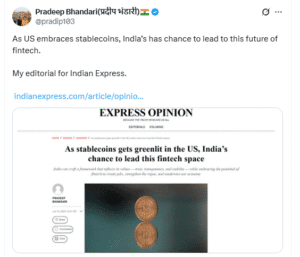India’s Stablecoin Revolution: Seizing the Fintech Future
In a bold call to action, Pradeep Bhandari, national spokesperson for India’s ruling Bharatiya Janata Party (BJP), has urged the government to fast-track stablecoin regulation to cement India’s position as a global fintech powerhouse. In a recent post on X, Bhandari declared, “With the U.S. charging ahead on stablecoin adoption, India must act decisively to shape the future of fintech.” His words signal a critical moment for India to harness blockchain technology and ride the wave of digital finance innovation.

The Global Stablecoin Race: U.S. Sets the Pace
The United States is already making waves in the stablecoin arena. In June 2025, the U.S. Senate passed the GENIUS Act, a landmark law allowing banks and corporate giants like Amazon and Walmart to issue stablecoins backed 1:1 by U.S. Treasury Bills. These digital assets combine the rock-solid stability of government securities with blockchain’s lightning-fast efficiency, revolutionizing global payments and reinforcing the U.S. dollar’s digital dominance. From seamless cross-border transactions to secure digital wallets, stablecoins are reshaping how money moves in the modern world.
Meanwhile, nations like Japan and Singapore are also advancing their own stablecoin frameworks, creating robust ecosystems that attract blockchain talent and investment. The message is clear: the global fintech race is on, and India cannot afford to lag behind.
Why Stablecoins Matter for India
Stablecoins—digital currencies pegged to stable assets like fiat currency or government bonds—offer far more than financial innovation. For India, they represent a transformative opportunity to modernize the economy, stabilize the rupee, and enhance financial inclusion. Here’s how:
-
Lower Borrowing Costs: India’s borrowing costs hover around 6%, a significant burden on economic growth. Bhandari envisions tokenized government debt—digital bonds issued on blockchain with stringent regulatory oversight—as a game-changer. These could attract global investors, reduce interest rates, and build trust in digital currencies while safeguarding India’s financial sovereignty.
-
Economic Modernization: Stablecoins integrate seamlessly with digital wallets, tax systems, and cross-border payments. India’s world-class digital infrastructure, including UPI and Aadhaar, provides a strong foundation to deploy stablecoins at scale, streamlining transactions and boosting efficiency.
-
Job Creation and Innovation: By fostering a blockchain-friendly ecosystem, India could become a global hub for fintech innovation. Cities like Bengaluru, Delhi, and Mumbai could see a surge in high-skill jobs, with startups thriving in a regulated environment. However, regulatory uncertainty has already pushed many Indian blockchain developers to hubs like Dubai and Singapore. Clear rules could bring them back—and attract global talent.
-
Financial Inclusion: With over 1.4 billion people, India’s unbanked population remains a challenge. Stablecoins, accessible via smartphones, could bring millions into the financial mainstream, enabling secure, low-cost transactions for rural and urban communities alike.
The Risks of Inaction
The Supreme Court of India has sounded the alarm, warning that the absence of cryptocurrency regulation risks creating a gray market—a breeding ground for fraud and instability. Without clear guidelines, India’s fintech potential could be stifled, leaving the country vulnerable to exploitation and lagging in the global digital economy. Aishwary Gupta, Global Head of Payments at Polygon Labs, emphasizes that the U.S.’s robust crypto regulations are legitimizing digital assets and encouraging traditional finance to embrace blockchain. India, a pioneer in technologies like UPI, risks losing its Web3 edge without bold action.
The Near Future: A Transformative Impact
If India acts swiftly, the impact of stablecoin adoption could be profound:
-
By 2030, Stablecoins Could Power 20% of India’s Digital Transactions: With UPI already processing billions of transactions annually, stablecoins could enhance its capabilities, enabling instant, low-cost global payments for businesses and individuals.
-
Rupee Stabilization: Stablecoins pegged to the rupee could reduce volatility in cross-border trade, making Indian exports more competitive and shielding the economy from currency fluctuations.
-
A Fintech Boom: Clear regulations could unleash a wave of blockchain startups, positioning India as a rival to Singapore and Dubai. This could create millions of jobs in tech, finance, and cybersecurity over the next decade.
-
Global Leadership: By integrating stablecoins with India’s digital infrastructure, the country could set a global standard for fintech innovation, attracting foreign investment and talent.
A Call to Action
Bhandari’s vision is clear: transparent, value-aligned regulations are the key to unlocking India’s fintech potential. Stablecoins could stabilize the rupee, modernize the economy, and empower millions through financial inclusion. But time is of the essence. As the U.S., Japan, and others forge ahead, India must act now to avoid being left behind.
The opportunity is immense. With its unmatched digital infrastructure and vibrant tech ecosystem, India is uniquely positioned to lead the stablecoin revolution. By embracing blockchain and regulating stablecoins, the nation can secure its place as a global fintech leader, driving innovation, prosperity, and inclusion for generations to come.




